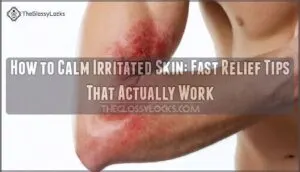This site is supported by our readers. We may earn a commission, at no cost to you, if you purchase through links.

Start with a cold compress for 10-15 minutes to reduce inflammation and numb that maddening itch. Next, slap on some fragrance-free moisturizer while your skin’s still damp to lock in hydration.
Skip the fancy products for now—they’re probably what started this mess anyway. Gentle cleansers and lukewarm water become your new best friends.
If you’re dealing with contact dermatitis or mysterious redness, antihistamines can help from the inside out. The secret isn’t just stopping the fire—it’s understanding what lit the match in the first place, and finding a way to cool it down and lock in hydration.
Table Of Contents
- Key Takeaways
- Causes of Irritated Skin
- Calming Irritated Skin
- Natural Remedies for Relief
- Preventing Future Irritation
- Medical Treatment Options
- Frequently Asked Questions (FAQs)
- Can natural skin care help irritated skin?
- What should I do if my skin is irritated?
- How to prevent skin irritation?
- How can I get rid of irritated skin faster?
- Why is my skin irritated?
- Are these 6 skincare tips good for calming flare-ups?
- How do you get rid of irritated skin fast?
- What is the best thing to soothe irritated skin?
- How long does it take for irritated skin to calm down?
- How long does skin irritation typically last?
- Conclusion
Key Takeaways
- Cool it down immediately – Apply cold compresses for 10-15 minutes to reduce inflammation and numb itching, then follow with fragrance-free moisturizer while your skin’s still damp to lock in hydration.
- Ditch harsh products temporarily – Skip fancy skincare items, acids, and fragranced products that likely caused the irritation, and stick to gentle cleansers with lukewarm water until your skin calms down.
- Try natural remedies that actually work – Use proven options like oatmeal baths, aloe vera gel, or green tea compresses to soothe inflammation without adding more chemicals to your angry skin.
- Build prevention habits for the long haul – Switch to gentler routines with patch testing, maintain 30-50% humidity indoors, choose breathable fabrics, and avoid over-cleansing to prevent future flare-ups.
Causes of Irritated Skin
Your skin rebels when you overload it with harsh chemicals like benzoyl peroxide or when winter weather strips away its natural defenses.
Understanding what triggers your irritation—whether it’s aggressive skincare products, environmental stressors, or underlying conditions like eczema—helps you tackle the problem instead of just treating the symptoms.
Harsh Chemicals in Skincare
Behind every red, itchy breakout lies a chemical culprit.
One in eight ingredients in skincare products contains industrial chemicals that can soothe irritated skin or cause chemical overload instead. Many products contain ingredients that can be harmful, such as endocrine disrupting parabens.
Your skin becomes a chemistry experiment when one in eight skincare ingredients contains industrial-grade chemicals.
Common chemical irritants include:
- Synthetic Dyes and Fragrance Allergens – These sneaky additives trigger reactions in 20% of users, causing redness faster than you can say "hypoallergenic"
- Sulfate Concerns – These harsh cleansers strip your skin’s natural oils, leaving it tighter than your jeans after Thanksgiving dinner
- Preservative Sensitization – Parabens and formaldehyde affect 2-3% of people, turning your beauty routine into a chemistry experiment gone wrong
Environmental Factors Like Cold Weather
Mother Nature can be your skin’s worst enemy during colder months.
Environmental factors like cold weather strip your skin’s natural moisture barrier, leaving you vulnerable to Winter Itch and painful Barrier Damage.
Low Humidity Impact creates the perfect storm for skin irritation.
| Environmental Trigger | Effect on Skin |
|---|---|
| Cold temperatures | Vasoconstriction reduces blood flow |
| Low humidity | Accelerates moisture loss |
| Wind exposure | Increases transepidermal water loss |
Cold Urticaria affects some people when exposed to chilly air.
Combat these environmental factors by wearing Protective Clothing and using gentle products to moisturize regularly.
Simple habits can soothe irritated skin and calm skin irritation before winter wreaks havoc.
Underlying Skin Conditions
Sometimes your skin rebels not because of what you put on it, but because of what’s already going on inside.
Sometimes the enemy is coming from inside the house—your own skin’s internal chaos.
Chronic skin conditions like eczema, psoriasis, and rosacea create ongoing inflammation that makes your skin extra sensitive to everything else.
- Eczema triggers flare-ups through genetic predisposition and immune dysfunction, affecting over 31 million Americans
- Psoriasis management involves controlling autoimmune responses that create scaly, inflamed plaques
- Rosacea symptoms include facial redness and irritation, often mistaken for allergic reactions
- Dermatitis from contact allergens can develop sensitivity over time, even to previously tolerated products
Skin inflammation can also arise from allergic reactions to various substances.
Calming Irritated Skin
When your skin feels like it’s staging a revolt, don’t panic—you’ve got options.
The key to calming irritated skin lies in barrier repair and hydration importance. Cool compresses provide immediate itch relief within minutes, while gentle soothing techniques reduce skin redness.
For enhanced calming, consider serums with ingredients that strengthen the skin barrier. Check product ingredients carefully—fragrance-free moisturizers work best for skin soothing.
| Quick Relief Method | Application Time | Expected Results |
|---|---|---|
| Cool compress | 10-15 minutes | Reduces redness, numbs irritation |
| Fragrance-free moisturizer | Apply immediately | Restores hydration, prevents flaking |
| Hydrocortisone 1% cream | 2-3 times daily | 70% symptom reduction in mild cases |
| Lukewarm water cleansing | Under 10 minutes | Preserves natural skin barrier |
| Pat (don’t rub) skin dry | After each wash | Prevents friction-induced damage |
Natural Remedies for Relief
When your skin throws a tantrum, nature’s got your back with remedies that actually work—no fancy lab required.
These time-tested treatments use ingredients you probably already have at home to calm inflammation and restore your skin’s happy place.
They are designed to calm inflammation and are time-tested.
Green Tea and Oatmeal Soaks
When your skin’s throwing a tantrum, green tea and oatmeal become your dynamic duo for instant relief.
Green tea benefits include powerful anti-inflammatory compounds that tackle redness, while oatmeal’s natural moisturizers repair your skin barrier.
This DIY soak recipe couldn’t be simpler: steep green tea bags, add colloidal oatmeal, and let the skin calming magic happen in your oatmeal bath.
You can easily find quality options online for a natural and effective solution.
Aloe Vera Gel and Apple Cider Vinegar
Aloe vera gel offers immediate relief for irritated skin with its anti-inflammatory and antimicrobial healing properties. Apple cider vinegar (ACV) helps restore your skin’s natural pH balance when properly diluted. Both work across different skin types when used consistently.
Here’s your game plan for calming relief:
- Fresh aloe application: Break open a leaf, squeeze out gel, apply twice daily for maximum soothing power
- ACV dilution magic: Mix 1 part vinegar with 3 parts water – your skin will thank you for the gentle approach
- Patch test first: Test on a small area because even natural doesn’t always mean irritation-free
- Usage frequency matters: Start slow with every other day, then increase as your skin adapts to avoid overdoing it
Cold Milk and Bentonite Clay
Your grandmother’s old-school milk compress wasn’t just folklore—cold milk’s proteins and fats genuinely soothe irritated skin by reducing heat and inflammation instantly.
For deeper cleansing, bentonite clay‘s negative charge draws out toxins and bacteria when mixed with water into a paste.
Apply clay masks for 15-20 minutes weekly to calm skin irritation and reduce blemishes naturally. You can also try colloidal oatmeal uses for a comforting effect.
Peppermint Leaves and Plantain Leaves
Imagine this: your skin’s throwing a tantrum, and you’re desperately searching through your kitchen like some herbal MacGyver.
Peppermint benefits include menthol’s cooling sensation that instantly calms irritated skin while fighting acne-causing bacteria.
Plantain applications involve crushing fresh plantain leaves (nature’s antihistamine) and applying directly for immediate itch relief.
These herbal remedies pack serious anti-inflammatory punch—just prepare leaves properly and enjoy natural skin irritation relief.
Preventing Future Irritation
Once you’ve calmed your angry skin, it’s time to play defense so it doesn’t throw another tantrum.
The key is switching to gentler habits and creating a protective environment that keeps irritation at bay before it starts.
Gentle Skincare Routines
Beyond natural remedies, you’ll want to rebuild your skincare routine from scratch.
Think minimalist skincare – less is definitely more when dealing with irritated skin.
Start with patch testing any new products on your inner arm first.
Choose a gentle cleanser that won’t strip your barrier, then follow with one thick moisturizer focused on barrier repair.
Many people find relief using a specially formulated cleanser.
Skip product layering until your skin calms down.
Humidifiers and Hydrating Foods
While winter’s harsh air can turn your skin into a desert, strategic changes to your environment and diet create lasting relief.
Combat dryness with Humidifier Benefits that restore moisture to parched indoor air.
- Use a humidifier to maintain 30-50% humidity levels for ideal Skin Moisture
- Increase Water Intake to at least 3 liters daily for Dietary Hydration
- Choose antiinflammatory foods like salmon, leafy greens, and avocado for Preventative Eating
- Add walnuts and fish oil supplements to support skin barrier function
- Monitor your Food Choices – avoid gluten, dairy, and sugar that worsen Irritated skin
Avoiding Harsh Cleansers and Soaps
Your skin’s natural defenses crumble when harsh soaps strip away protective natural lipids.
Ditch sulfate-laden cleansers that turn your face into a desert landscape.
Instead, embrace gentle alternatives with pH-balanced formulas that actually respect your skin barrier.
Sensitive skin deserves soap alternatives with gentle ingredients that cleanse without declaring war on your complexion.
Wearing Protective Clothing
Don’t let your wardrobe become your skin’s worst enemy. Choose soft, breathable Clothing Materials like cotton over synthetic fabrics that trap irritants against your skin.
Long sleeves provide excellent Sun Protection and Physical Barriers against Chemical Exposure from cleaning products or allergens.
For Activity Specific protection, wear gloves when gardening or cleaning – your hands will thank you later. To further reduce sun damage, consider wearing UPF-rated clothing.
These simple skin care for irritated skin strategies prevent irritation before it starts, using Physical Barriers and providing Chemical Exposure protection.
Medical Treatment Options
Sometimes your skin needs more than a DIY oatmeal mask to get back on track.
When over-the-counter treatments become your best friend, you’ll want to know which ones actually work.
When it’s time to call in the professionals.
Calamine Lotion and Hydrocortisone Cream
Sometimes gentle skincare routines aren’t enough, and you’ll need backup firepower. Calamine lotion acts like your skin’s chill pill, containing zinc oxide that dries oozing blisters while reducing inflammation.
Hydrocortisone cream packs more punch with its anti-inflammatory strength, typically applied once or twice daily for quick itching relief. You can find various brands available on the market.
Here’s what these skin-savers offer:
- Calamine benefits include instant cooling relief for poison ivy and bug bites
- Hydrocortisone strength reduces redness and swelling within hours
- Simple application methods make treatment hassle-free
- Short usage duration prevents side effects like skin thinning
Both treatments work fast, but hydrocortisone shouldn’t be used long-term without medical supervision.
Emergency Care for Severe Reactions
While hydrocortisones handle most irritation, some situations demand immediate medical attention. Watch for Anaphylaxis Symptoms like throat tightness, difficulty breathing, or Severe Swelling beyond the original irritation site.
These aren’t your typical skin allergies—they’re medical emergencies requiring epinephrine, not antihistamines. Extreme Itching accompanied by fever, spreading rash, or Infection Signs (pus, yellow crusting) warrants Urgent Evaluation.
Proper hygiene and disinfecting razor blades can minimize infection risks. Don’t tough it out when your skin screams for help.
Call emergency services if breathing becomes labored or swelling spreads rapidly. Your dermatologist can wait, but anaphylaxis can’t.
Frequently Asked Questions (FAQs)
Can natural skin care help irritated skin?
Mother Nature’s pharmacy isn’t just folklore—it’s backed by science!
Natural remedies like oatmeal, aloe vera, and green tea contain anti-inflammatory compounds that genuinely soothe irritated skin without harsh chemicals your skin might revolt against.
What should I do if my skin is irritated?
Stop everything you’re doing and gently cleanse with lukewarm water.
Apply a cool compress for ten minutes, then use fragrance-free moisturizer.
Skip harsh products and avoid scratching—your skin’s basically throwing a tantrum right now.
How to prevent skin irritation?
Think of your skin like a fortress – you’ll want to build strong defenses before the enemy attacks.
Choose gentle, fragrance-free products, moisturize consistently, avoid over-cleansing, and protect your skin barrier daily.
How can I get rid of irritated skin faster?
Apply cool compresses immediately, then use hydrocortisone cream and fragrance-free moisturizer.
Oatmeal baths work wonders for larger irritated areas.
Skip harsh products and let your skin breathe—it’ll thank you later.
Why is my skin irritated?
Your skin’s throwing a tantrum because you’ve likely overloaded it with harsh products, acids, or excessive scrubbing.
Environmental factors like cold weather, hot showers, or irritating ingredients can also trigger this rebellion, which is often a result of harsh products.
Are these 6 skincare tips good for calming flare-ups?
Looking for the magic six to tame your angry skin?
Without seeing your specific tips, I can’t judge their merit.
Generally, gentle cleansing, cool compresses, fragrance-free moisturizers, and avoiding harsh ingredients work wonders for flare-ups.
How do you get rid of irritated skin fast?
Cool compresses and gentle, fragrance-free moisturizer work fastest—think ice-cold relief meeting barrier repair. Skip harsh products that’ll make your skin angrier than a hangry toddler.
What is the best thing to soothe irritated skin?
Sarah’s face turned red and stung after trying that trendy new serum everyone raved about online.
Cool compresses work best—they’ll reduce inflammation within minutes.
Apply ice wrapped in cloth for ten-minute intervals, then follow with fragrance-free moisturizer to restore your skin’s protective barrier.
How long does it take for irritated skin to calm down?
Most irritated skin bounces back within 3-7 days with proper care, though stubborn cases might take 2-4 weeks. Your skin’s healing speed depends on the cause and your treatment approach.
How long does skin irritation typically last?
Like a storm that eventually passes, your skin’s angry rebellion typically settles down within 3-7 days if you treat it gently and avoid further irritation triggers.
Conclusion
Think of your irritated skin like a house fire—once you’ve doused the flames, you’ve got to make sure the embers don’t reignite.
You’ve learned how to calm irritated skin with cold compresses, gentle moisturizers, and natural remedies that actually work.
The real victory isn’t just putting out today’s flare-up; it’s building fireproof habits that prevent future disasters, and your skin is counting on you to be both the firefighter and the fire marshal.









